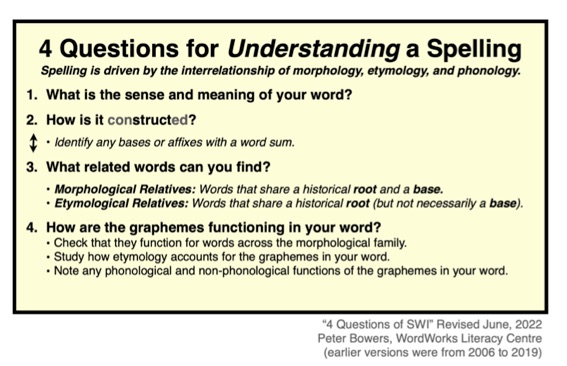Copyright Susan and Peter Bowers 2008


“Structured word inquiry” Bowers and Kirby (2010) literacy instruction that engages learners of all ages and abilities by making sense of our surprisingly logical spelling system. English spelling can only be understood through scientific investigation of the interrelationship of morphology (bases & affixes), etymology (historical influences) and phonology (grapheme-phoneme correspondences).
The evidence from multiple meta-analyses is that morphological instruction brings literacy benefits to learners in general, but in particular for less able and younger students (see more on research on back).
According to the research morphology should be a feature of instruction from the start. However, we have little research about how best to teach teach morphology. Research on SWI is promising, but has only just begun. The practical work gong on with SWI in classrooms and tutoring around the world offers educators and researches needed models of what such instruction can look like. See an interview with Dr. Bowers on SWI HERE.
Orthographic-phonology makes sense of grapheme-phoneme correspondences phonics instruction describes as “irregular.”
Those born with efficient orthographic memories just learn to read and spell words like does without pausing to think about the grapheme-phoneme correspondences they were taught. Lacking automated access to such spellings, the dyslexic pauses to draw on their instruction. The misspelling *<duz> is the result of a dyslexic successfully applying hard won learning. This is not a motivating learning experience.
Nothing motivates like understanding
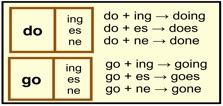
Instruction from a phonics perspective treats <does> is “irregular,” but when we investigate the structure and meaning of this word and its family we can make sense of its spelling. The base <do> keeps its spelling regardless of it’s pronunciation. This is not “irregular,” it is how grapheme-phoneme correspondences operate in a morphophonemic system.
Why does my child spell <jumped> as *<jumpt>?
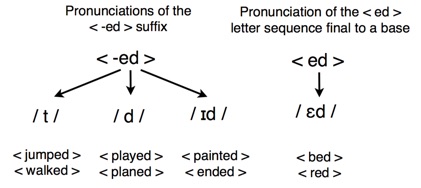
But when we look at the structure we see the <-ed> suffix for the past tense is always spelled <-ed>, no matter how it is pronounced!
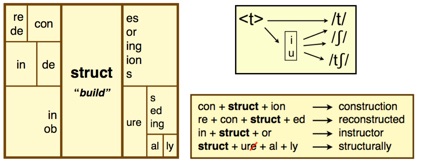
All words built on the English base (morphology) <struct> derive from the The Latin root (etymology) rumpere for “build” which informs the meaning of any word with the <struct> base. This base has multiple pronunciations, but only one spelling.
Introduction to the research
Structured word inquiry (SWI) (Bowers & Kirby, 2010) is NOT morphological instruction. Structured word inquiry is literacy instruction that uses a scientific inquiry approach to build understanding English orthography represents the meanings of words to speakers of the language through an interrelation of morphology, etymology and phonology. As Venezky (1999) explained, “English orthography is not a failed phonetic transcription system, invented out of madness or perversity. Instead, it is a more complex system that preserves bits of history (i.e., etymology), facilitates understanding, and also translates into sound” (p. 4).
SWI is not morphological instruction, but it must teach about morphology. As a result we can gain some insight from the results of research on the effects of including morphological in literacy instruction. The results are in direct contradiction to decades of (untested) recommendations from the research to avoid inclusion of morphology in instruction to younger and less able readers. See the table below with the results of meta- analyses of morphological instruction.
Orthographic phonology is essential to SWI Instruction -- and morphological instruction builds phonological awareness
Please keep in mind that SWI instruction requires explicit, rigorous instruction of orthographic phonology. This is the linguistic term that describes how the grapheme- phoneme correspondences work within the context of morphological and etymological constraints. The research shows that morphological instruction benefits phonological outcomes. Goodwin an Ahn found the greatest effects of morphological instruction in their meta-analyses (2010,2013) were for phonological outcomes. They explained, “Similar to Bowers et al. (2010), results suggest that early morphological instruction may be particularly helpful perhaps because of the synergistic relationship between phonology and morphology and the larger repertoire of root [base] and affix meanings available for use. If a reciprocal relationship exists between morphological knowledge and literacy...it makes sense to jump start this knowledge from an early age” (Goodwin & Ahn, 2013, p. 23).
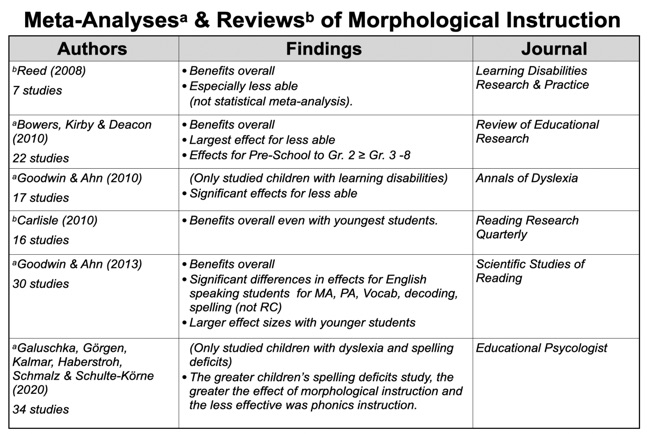
Research Links
At the bottom of the About WordWorks page are links to most of Dr. Bowers’ published research.
The Bowers & Kirby (2010) that introduced the term “structured word inquiry” is at THIS LIINK
The most accessible article on SWI and its place in the research is titled, Structured Word Inquiry (SWI): Literacy instruction that makes sense of English spelling for students of all ages and abilities. (Bowers, 2022) available HERE.
See Pete’s TEDx talk (18 min) for a helpful introduction to the big picture of SWI HERE.
See Pete’s interview on SWI with Education Podcast ‘Pedagogy Non-Grata” (April 2021) ini 3 parts;
-
-Video 1 is HERE. (1 hr, 13 min)
-
-Video 2 is HERE. (33 min)
-
-Video 3 is HERE. (35 min -- research focus)
Those interested in the research discussion can find it near the end of video 2 at the 29 minute mark at THIS LINK. That discussion continues in Video 3 (33 min).
The “4 Questions of Structured Word inquiry”
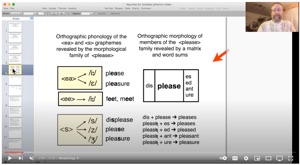
Question #4 on graphemes is not last because it is lease important. It is last because one can’t come to any safe conclusions about grapheme-choice ini a word until you have considered morphological and etymological factors that constrain and explain grapheme choice.
See THIS video for an explanation of this view.
